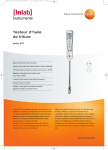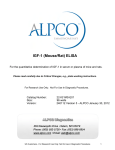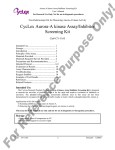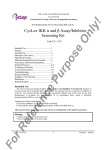Download CY-1176
Transcript
t. uc od ur pr Polo-like kinase 3 Assay/Inhibitor Screening Kit User’s Manual For Research Use Only, Not for use in diagnostic procedures ith yo Non-Radioisotopic Kit for Measuring Plk3 activity m ew CycLex Polo-like kinase 3 Assay/Inhibitor Screening Kit at th al an u rm se re fe rt o th eu Intended Use................................................ 1 Storage......................................................... 1 Introduction.................................................. 2 Principle of the Assay.................................. 3 Materials Provided....................................... 4 Materials Required but not Provided........... 4 Precautions and Recommendations............. 5 Detailed Protocol......................................... 6-9 Evaluation of Results................................... 10 Assay Characteristics................................... 10 Troubleshooting............................................10 Reagent Stability...........................................10 Example of Test Results................................11-13 References.....................................................14 Related Products.......................................... 14 ca Cat# CY-1176 Intended Use nl y! Pl ea se The CycLex Research Product CycLex Polo-like kinase 3 Assay /Inhibitor Screening Kit designed to measure the activities of purified Plk3 for the rapid and sensitive evaluation of inhibitors or activators. The sequence-specific phosphoserine monoclonal antibody used in this assay kit has been demonstrated to recognize the phosphoserine residue in recombinant “Plk3-substrate-1”, which is efficiently phosphorylated by Plk3 in vitro. eO Applications of this kit include: 1) Screening inhibitors or activators of Plk3. 2) Detecting the effects of pharmacological agents on Plk3 activity. Pu rp Storage os This assay kit is for research use only and not for use in diagnostic or therapeutic procedures. er en ce • Upon receipt store all components at 4°C. • Don’t expose reagents to excessive light. Fo rR ef Cat#: CY-1176 1 Version#: 140318 t. uc od yo ur pr Polo-like kinase 3 Assay/Inhibitor Screening Kit User’s Manual For Research Use Only, Not for use in diagnostic procedures ith Introduction se rm an u al th at ca m ew The polo-like kinases (Plks) are a family of conserved serine/threonine kinases that play a critical role in the normal progression of cells through mitosis. The Plk3 serine/threonine kinase is a mammalian member of this family. In contract to Plk1, overexpression of Plk3 in mammalian cells suppresses proliferation and inhibits colony formation. Subsequent analysis demonstrated that overexpression of Plk3 induces chromatin condensation and apoptosis. One difference between Plk1 and the other two Plks is that both Plk2 and Plk3 were originally identified as immediate-early genes (1, 2), whereas Plk1 does not share this characteristic. The Plks have been implicated in the genesis or progression of tumors. Plk3 has been suggested as a candidate tumor suppressor (3), and its expression is down-regulated or absent in lung carcinomas (4) and squamous cell carcinomas of the head and neck (3). Plk3 contributes to regulation of M phase of the cell cycle (5). Plk3 physically interacts with Cdc25C and phosphorylates this protein phosphatase predominantly on serine 191 (6), suggesting that the role of Plk3 in mitosis is mediated, at least in part, through direct regulation of Cdc25C. In response to DNA damage, the kinase activity of Plk3 was rapidly increased in an ATM-dependent manner, whereas that of Plk1 was markedly inhibited. Co-immunoprecipitation and pull-down assays demonstrated that Plk3 physically interacted with p53 and that this interaction was enhanced upon DNA damage. Taken together, these studies indicate that Plk3 functionally links DNA damage to cell cycle arrest and apoptosis via the p53 pathway (7). eu Measurement of Plk3 activity er en ce Pu rp os eO nl y! Pl ea se re fe rt o th The protocol generally regarded as most sensitive for the quantitative measurement of Plk3 activity involves incubation of the Plk3 sample with substrate, either a natural or synthetic polypeptide (such as Cdc25C-S191 peptide; RRRDQAEEISDELMEF), in the presence of Mg2+ and 32P-labeled ATP. The reaction is terminated by "spotting" a sample onto a phosphocellulose P81 filter paper disc, followed by washing extensively to remove unincorporated radiolabel and the incorporated radioactivity on P81 filter is counted. While sensitive, this method is labor-intensive, generates hazardous radioactive waste, and depends on a radioisotope of short half-life. It is particularly unsuitable when kinase assays are only performed on an infrequent basis. The CycLex Research Product CycLex Polo-like kinase 3 Assay /Inhibitor Screening Kit uses a peroxidase coupled anti-phospho-Plk3-substrate-1 monoclonal antibody as a reporter molecule in a 96-well ELISA format. This assay provides a non-isotopic, sensitive and specific method to detect Plk3 activity. Fo rR ef Cat#: CY-1176 2 Version#: 140318 t. uc od yo ur pr Polo-like kinase 3 Assay/Inhibitor Screening Kit User’s Manual For Research Use Only, Not for use in diagnostic procedures ith Principle of the Assay eu se rm an u al th at ca m ew The CycLex Research Product CycLex Polo-like kinase 3 Assay /Inhibitor Screening Kit is a single-site, semi-quantitative immunoassay for Plk3 activity. Plates are pre-coated with a substrate corresponding to recombinant “Plk3 substrate-1”, which contains a serine residue that is phosphorylated by Plk3 (Polo-like kinase 3). The detector antibody specifically detects only the phosphorylated form of “Plk3 substrate-1”. The CycLex Research Product CycLex Polo-like kinase 3 Assay /Inhibitor Screening Kit can be used to study the kinetics of a purified or partially purified Plk3 as well as to screening these kinases inhibitor. To perform the test, the sample is diluted in Kinase Buffer, pipetted into the wells and allowed to phosphorylate the bound substrate in the presence of Mg2+ and ATP. The amount of phosphorylated substrate is measured by binding it with a horseradish peroxidase conjugate of KS-3H4, an anti-phospho-“Plk3 substrate-1” specific antibody, which then catalyzes the conversion of the chromogenic substrate tetra-methylbenzidine (TMB) from a colorless solution to a blue solution (or yellow after the addition of stopping reagent). The color is quantified by spectrophotometry and reflects the relative amount of Plk3 activity in the sample. For kinetic analysis, the sample containing Plk3 is added to the wells in a similar fashion and at varying times the reaction is stopped by the addition of a chelator, sodium ethylenediaminetetraacetate (EDTA) and the amount of phosphorylated substrate determined as before. The CycLex Research Product CycLex Polo-like kinase 3 Assay /Inhibitor Screening Kit is designed to accurately determine the presence and relative amount of Plk3 kinase activity to determine non-isotopic kinetic analysis of Plk3 activity. o th Summary of Procedure rt Add 100 µL of reaction mix to the wells fe Incubate for 60 min at 30°C se re Wash the wells Incubate for 60 min at room temp. Pl ea Add 100 µL of HRP conjugated anti-phosphorylated form specific antibody nl y! Wash the wells er en ce Pu rp os eO Add 100 µL of Substrate Reagent Fo rR ef Cat#: CY-1176 Add 100 µL of Stop Solution Measure absorbance at 450 nm 3 Version#: 140318 t. uc od yo ur pr Polo-like kinase 3 Assay/Inhibitor Screening Kit User’s Manual For Research Use Only, Not for use in diagnostic procedures ith Materials Provided ew All samples and standards should be assayed in duplicate. The following components are supplied and are sufficient for the one 96-well microtiter plate kit. at 10X Wash Buffer: One 100 mL bottle of 10X buffer containing 2%Tween®-20 ca m Microplate: One microplate supplied ready to use, with 96 wells (12 strips of 8-wells) in a foil, zip-lock bag with a desiccant pack. Wells are coated with recombinant “Plk3 substrate-1” as substrate of Plk3. al th Kinase Buffer: One bottle containing 20 mL of 1X buffer; used for Kinase Reaction Buffer and sample dilution. an u 20X ATP: One vial of lyophilized ATP Na2 salt. rm HRP conjugated Detection Antibody: One vial containing 12 mL of HRP (horseradish peroxidase) conjugated anti-phospho-“Plk3 substrate-1” monoclonal antibody (KS-3H4). Ready to use. eu se Substrate Reagent: One bottle containing 20 mL of the chromogenic substrate, tetra methylbenzidine (TMB). Ready to use. Stop Solution: One bottle supplied ready to use, containing 20 mL of 1 N H2SO4. o th Materials Required but not Provided er en ce Pu rp os eO nl y! Pl ea se re fe rt • Plk3 positive control: Available from CycLex (Cat # CY-E1176), One vial contains 1.6 units/200 µL (8 m units/µL) Plk3 enzyme. Positive control should be added to the first well at ca. 8 m units/well. Unused Plk3 enzyme should be stored in aliquots at below -70°C. • 10X Staurosporine (100 µM): Staurosporine is available from Sigma, Cat#. S-4400. 10 mM stock solution (DMSO) diluted 1:100 in Kinase Buffer. • Pipettors: 2-20 µL, 20-200 µL and 200-1000 µL precision pipettors with disposable tips. • Precision repeating pipettor • Wash bottle or multichannel dispenser for plate washing. • Microcentrifuge and tubes for sample preparation. • Vortex mixer • Plate reader capable of measuring absorbance in 96-well plates at dual wavelengths of 450 nm/540 nm. Dual wavelengths of 450/550 or 450/595 nm can also be used. The plate can also be read at a single wavelength of 450 nm, which will give a somewhat higher reading. • 500 or 1000 mL graduated cylinder • Reagent reservoirs • Deionized water of the highest quality • Disposable paper towels Fo rR ef Cat#: CY-1176 4 Version#: 140318 t. uc od yo ur pr Polo-like kinase 3 Assay/Inhibitor Screening Kit User’s Manual For Research Use Only, Not for use in diagnostic procedures ith Precautions and Recommendations ew • Store the ATP at -20°C in aliquots. Store all other components at 4°C. Do not expose reagents to excessive light. Avoid freeze/thaw cycles. m • Allow all the components to come to room temperature before use. at ca • All microplate strips that are not immediately required should be returned to the zip-lock pouch, which must be carefully resealed to avoid moisture absorption. th • Do not use kit components beyond the indicated kit expiration date. al • Use only the microtiter wells provided with the kit. an u • Rinse all detergent residue from glassware. rm • Use deionized water of the highest quality. se • Do not mix reagents from different kits. th • Do not mouth pipet or ingest any of the reagents. eu • The buffers and reagents in this kit may contain preservatives or other chemicals. Care should be taken to avoid direct contact with these reagents. fe rt o • Do not smoke, eat, or drink when performing the assay or in areas where samples or reagents are handled. re • Dispose of tetra-methylbenzidine (TMB) containing solutions in compliance with local regulations. se • Avoid contact with Substrate Solution which contains hydrogen peroxide. ea • Avoid contact with Stop Solution which contains Sulfuric Acid. nl y! Pl • In case of contact with the Stop Solution and the Substrate Solution, wash skin thoroughly with water and seek medical attention, when necessary. eO • Biological samples may be contaminated with infectious agents. Do not ingest, expose to open wounds or breathe aerosols. Wear protective gloves and dispose of biological samples properly. er en ce Pu rp os • CAUTION: Sulfuric Acid is a strong acid. Wear disposable gloves and eye protection when handling Stop Solution. Fo rR ef Cat#: CY-1176 5 Version#: 140318 t. uc od yo ur pr Polo-like kinase 3 Assay/Inhibitor Screening Kit User’s Manual For Research Use Only, Not for use in diagnostic procedures ith Detailed Protocol ca m ew The CycLex Research Product CycLex Polo-like kinase 3 Assay /Inhibitor Screening Kit is provided with removable strips of wells so the assay can be carried out on separate occasions using only the number of strips required for the particular determination. Since experimental conditions may vary, an aliquot of the Plk3 (Cat # CY-E1176), available separately from CycLex, should be included in each assay as a positive control. Disposable pipette tips and reagent troughs should be used for all liquid transfers to avoid cross-contamination of reagents or samples. th at Preparation of Working Solution an u al 1. Prepare a working solution of Wash Buffer by adding 100 mL of the 10X Wash Buffer (provided) to 900 mL of ddH2O. Mix well. Store at 4°C for two weeks or -20°C for long-term storage. rm 2. Prepare 20X ATP Solution by adding 1.6 mL of ddH2O to the vial of 20X ATP (provided, lyophilized). Mix gently until dissolved. The final concentration of the 20X ATP Solution should be 1.25 mM. Store the solution in small aliquots (e.g. 100 µL) at -20°C. se 3. Prepare Kinase Reaction Buffer by mixing following reagents. 10 assays 1 assay 9.5 mL 0.5 mL 950 µL 50 µL 95 µL 5 µL 10 mL 1000 µL 100 µL eu 96 assays th Kinase Buffer (provided) 20X ATP Solution rt o Total re fe You will need 80-90 µL of Kinase Reaction Buffer per assay well. Mix well. Discard any unused Kinase Reaction Buffer after use. se Standard Assay Pl ea 1. Remove the appropriate number of microtiter wells from the foil pouch and place them into the well holder. Return any unused wells to the foil pouch, refold, seal with tape and store at 4°C. nl y! 2. Prepare all samples (diluted with Kinase Buffer as needed). All samples should be assayed in duplicate. os eO 3. To assay partially purified recombinant Plk3, add 10 µL of each fraction to the wells of the assay plate on ice. Duplicate wells containing 8 m units/10 µL Plk3 positive control (Cat # CY-E1176) should be included in each assay as a positive control for phosphorylation. Pu rp 4. Begin the kinase reaction by addition of 90 µL Kinase Reaction buffer per well, cover with plate sealer, and incubate at 30°C for 60 minutes. er en ce 5. Wash wells five times with Wash Buffer making sure each well is filled completely. Remove residual Wash Buffer by gentle tapping or aspiration. 6. Pipette 100 µL of HRP conjugated Detection Antibody into each well, cover with a plate sealer and incubate at room temperature (ca.25°C) for 60 minutes. Discard any unused conjugate. Fo rR ef Cat#: CY-1176 6 Version#: 140318 t. uc od ur pr Polo-like kinase 3 Assay/Inhibitor Screening Kit User’s Manual For Research Use Only, Not for use in diagnostic procedures ith yo 7. Wash wells five times with Wash Buffer making sure each well is filled completely. Remove residual Wash Buffer by gentle tapping or aspiration. ew 8. Add 100 µL of Substrate Reagent to each well and incubate at room temperature (ca.25°C) for 5–15 minutes. ca m 9. Add 100 µL of Stop Solution to each well in the same order as the previously added Substrate Reagent. al th at 10. Measure absorbance in each well using a spectrophotometric plate reader at dual wavelengths of 450/540 nm. Dual wavelengths of 450/550 or 450/595 nm can also be used. Read the plate at 450 nm if only a single wavelength can be used. Wells must be read within 30 minutes of adding the Stop Solution. rm an u Note-1: Complete removal of liquid at each step is essential to good performance. After the last wash, remove any remaining Wash Buffer by aspirating or decanting. Invert the plate and blot it against clean paper towels. se Note-2: Reliable signals are obtained when either O.D. values do not exceed 0.25 units for the blank (no enzyme control), or 2.5 units for the Plk3 positive control. o th eu Note-3: If the microplate reader is not capable of reading absorbance greater than the absorbance of the Wee1 positive control, perform a second reading at 405 nm. A new O.D. values, measured at 405 nm, is used to determine Plk3 activity of off-scale samples. The readings at 405 nm should not replace the on-scale readings at 450 nm. fe rt Kinetic Assay se re 1. Remove the appropriate number of microtiter wells from the foil pouch and place them into the well holder. Return any unused wells to the foil pouch, refold, seal with tape and store at 4°C. ea 2. Prepare all samples (diluted with Kinase Buffer as needed). All samples should be assayed in duplicate. nl y! Pl 3. To assay partially purified recombinant Plk3, add 10 µL of each fraction to the wells of the assay plate on ice. Duplicate wells containing 8 m units/10 µL Plk3 positive control (Cat # CY-E1176) should be included in each assay as a positive control for phosphorylation. os eO 4. Begin kinase reaction by addition of 90 µL Kinase Reaction Buffer in duplicate per well in timed intervals (suggested interval is 5 minutes but should be individually determined for each system). After the final addition, incubate at 30°C for 30 minutes. Pu rp 5. Stop the reaction by flicking out the contents. (Alternatively, the reaction may be terminated by the addition of 150 µL 0.1 M Na EDTA, pH 8.0 to each well). er en ce 6. Wash wells five times with Wash Buffer making sure each well is filled completely. Remove residual Wash Buffer by gentle tapping or aspiration. 7. Pipette 100 µL of HRP conjugated Detection Antibody KS-3H4 into each well, cover with a plate sealer and incubate at room temperature (ca.25°C) for 60 minutes. Discard any unused conjugate after use. Fo rR ef Cat#: CY-1176 7 Version#: 140318 t. uc od yo ur pr Polo-like kinase 3 Assay/Inhibitor Screening Kit User’s Manual For Research Use Only, Not for use in diagnostic procedures ith 8. Wash wells five times as same as in step 6. ew 9. Add 100 µL of Substrate Reagent to each well and incubate at room temperature (ca.25°C) for 5-15 minutes. ca m 10 add 100 µL of Stop Solution to each well in the same order as the previously added Substrate Reagent. al th at 11. Measure absorbance in each well using a spectrophotometric plate reader at dual wavelengths of 450/540 nm. Dual wavelengths of 450/550 or 450/595 nm can also be used. Read the plate at 450 nm if only a single wavelength can be used. Wells must be read within 30 minutes of adding the Stop Solution. an u Recommendations o th eu se rm Special considerations when screening activators or inhibitors In order to estimate the inhibitory effect on Plk3 activity in the test chemicals correctly, it is necessary to conduct the control experiment of “Solvent control” at least once for every experiment and “Inhibitor control” at least once for the first experiment, in addition to “Test sample”, as indicated in the following table. When test chemicals cause an inhibitory effect on Plk3 activity, the level of A450 is weakened as compared with “Solvent control”. Inhibitor Assay reagents Test sample Solvent control control Kinase Reaction Buffer 80 µL 80 µL 80 µL rt 10X Inhibitor or equivalent - - - 10 µL - - - 10 µL 10 µL 10 µL fe Solvent for Inhibitor 10 µL re 10X Staurosporine (100 µM)* se Plk3 Positive Control (0.8 m unit/µL)** or your enzyme fraction 10 µL Pl ea * 10X Staurosporine (100 µM): See page 4, section “Materials Required but not Provided” ** Cat # CY-E1176: See page 4, section “Materials Required but not Provided” eO nl y! 1. Following the above table, add the Reagents to each well of the microplate. Finally, initiate reaction by adding 10 µL of “Diluted Plk3 positive control” to each well and mixing thoroughly at room temperature. Cover with plate sealer. Incubate at 30°C for 30 minutes. 2. Follow the Standard Assay, steps 5-10, page 6-7. Pu rp os Note: Although we suggest to conduct experiments as outlined in the table above, the optimal experimental conditions will vary depending on the parameters being investigated, and must be determined by the individual user. Especially, appropriate amount of Plk3 positive control must be determined by titration of the Plk3 positive control and setting the amount, which shows OD value does not exceed plateau range in dose response curve. er en ce NOTE: THE ABOVE PROCEDURES ARE INTENDED ONLY AS A GUIDELINE. THE OPTIMAL EXPERIMENTAL CONDITIONS WILL VARY DEPENDING ON THE PARAMETERS BEING INVESTIGATED, AND MUST BE DETERMINED BY THE INDIVIDUAL USER. NO WARRANTY OR GUARANTEE OF PERFORMANCE Fo rR ef Cat#: CY-1176 8 Version#: 140318 t. uc od ur pr Polo-like kinase 3 Assay/Inhibitor Screening Kit User’s Manual For Research Use Only, Not for use in diagnostic procedures ATP minus control - Kinase Buffer (provided) - - 90 µL 10X Staurosporine (100 µM)* - 10 µL - 10 µL 10 µL - - - - No enzyme control 90 µL - - - - 10 µL - - - 10 µL - - - 10 µL al an u rm Your enzyme fraction Plk3 Positive Control (0.8 m unit/µL)** Buffer Positive control 90 µL at Inhibitor control 80 µL th Kinase Reaction Buffer Test Sample 90 µL Assay reagents ca m ew ith yo USING THESE PROCEDURES IS MADE OR IMPLIED. Special considerations when measuring precise Plk3 activity In order to measure the activity of Plk3 correctly, it is necessary to conduct the control experiment of “Inhibitor control” at least once for every experiment and “ATP minus control” at least once for the first experiment, in addition to “No enzyme control” as indicated in the following table. Although the level of A450 increases in “Test sample” when Plk3 enzyme activity is in the sample, the high level of A450 is not observed in “Inhibitor control”, “ATP minus control” and “No enzyme control”. eu se * 10X Staurosporine (100 µM): See page 4, section “Materials Required but not Provided” **Cat # CY-E1176: See page 4, section “Materials Required but not Provided” o th 1. Following the above table, add the Reagents to each well of the microplate. Finally, initiate the reaction by adding 10 µL of “Your enzyme fraction” or “Buffer” to each well and mixing thoroughly at room temperature. Cover with plate sealer. Incubate at 30°C for 30 minutes. rt 2. Follow the Standard Assay, steps 5-10, page 6-7. ea se re fe Note: Although we suggest to conduct experiments as outlined in the table above, the optimal experimental conditions will vary depending on the parameters being investigated, and must be determined by the individual user. Especially, appropriate amount of Plk3 positive control must be determined by titration of the Plk3 positive control and setting the amount, which shows OD value does not exceed plateau range in dose response curve. er en ce Pu rp os eO nl y! Pl NOTE: THE ABOVE PROCEDURES ARE INTENDED ONLY AS A GUIDELINE. THE OPTIMAL EXPERIMENTAL CONDITIONS WILL VARY DEPENDING ON THE PARAMETERS BEING INVESTIGATED, AND MUST BE DETERMINED BY THE INDIVIDUAL USER. NO WARRANTY OR GUARANTEE OF PERFORMANCE USING THESE PROCEDURES IS MADE OR IMPLIED. Fo rR ef Cat#: CY-1176 9 Version#: 140318 t. uc od yo ur pr Polo-like kinase 3 Assay/Inhibitor Screening Kit User’s Manual For Research Use Only, Not for use in diagnostic procedures ith Evaluation of Results m ew 1. Average the absorbance values for the Plk3 sample duplicates (positive control) and all experimental sample duplicate values (when applicable). When the Plk3 positive control (8 m units/assay) is included as an internal control for the phosphorylation reaction, the absorbance value should be greater than 1.0 with a background less than 0.2. at ca 2. For screening of purification/chromatography fractions of recombinant Plk3, on graph paper, plot the mean absorbance values for each of the samples on the Y-axis versus the fraction number on the X-axis to determine the location of the eluted, purified Plk3. al th 3. For kinetic analysis, on graph paper, plot the mean absorbance values for each of the time points on the Y-axis versus the time of each reaction (minutes) on the X-axis. an u Assay Characteristics se rm The CycLex Research Product CycLex Polo-like kinase 3 Assay /Inhibitor Screening Kit has been shown to detect the activity of Plk3 in column fractions of recombinant Plk3. The assay shows good linearity of sample response. The assay may be used to follow the purification of recombinant Plk3. eu Troubleshooting rt o th 1. The Plk3 positive control should be run in duplicate, using the protocol described in the Detailed Protocol. Incubation times or temperatures significantly different from those specified may give erroneous results. se re fe 2. The reaction curve is nearly a straight line if the kinetics of the assay is of the first order. Variations in the protocol can lead to non-linearity of the curve, as can assay kinetics that are other than first order. For a non-linear curve, point to point or quadratic curve fit methods should be used. Pl ea 3. Poor duplicates, accompanied by elevated values for wells containing no sample, indicate insufficient washing. If all instructions in the Detailed Protocol were followed accurately, such results indicate a need for washer maintenance. eO nl y! 4. Overall low signal may indicate that desiccation of the plate has occurred between the final wash and addition of Substrate Reagent. Do not allow the plate to dry out. Add Substrate Reagent immediately after wash. os Reagent Stability er en ce Pu rp All of the reagents included in the CycLex Research Product CycLex Polo-like kinase 3 Assay /Inhibitor Screening Kit have been tested for stability. Reagents should not be used beyond the stated expiration date. Upon receipt, kit reagents should be stored at 4°C, except the ATP must be stored at -20°C. Coated assay plates should be stored in the original foil bag sealed by the zip lock and containing a desiccant pack. For research use only, not for use in diagnostic or therapeutic procedures Fo rR ef Cat#: CY-1176 10 Version#: 140318 t. uc od yo ur pr Polo-like kinase 3 Assay/Inhibitor Screening Kit User’s Manual For Research Use Only, Not for use in diagnostic procedures ith Example of Test Results m ew Fig.1 Dose dependency of recombinant Plk3 enzyme reaction ca Plk 3 d o s e d e p e nd e nc y 1.50 th at 2.00 al ATP + an u 1.00 rm A 4 50 ATP - se 0.50 0 eu 0.00 25 50 75 o th Plk 3 d o se (mU nit ) Time c o u rse se re fe rt Fig.2 Time course of recombinant Plk3 enzyme reaction nl y! 1.0 eO A4 5 0 1.5 Pl ea 2.0 er en ce Pu rp os 0.5 Fo rR ef Cat#: CY-1176 0.0 0 20 40 60 80 100 120 140 Re ac tio n time (min .) 11 Version#: 140318 t. uc od ew I n h ibit io n by S t au r o spo r in e m 120.0 ca 100.0 th at 80.0 al 60.0 40.0 an u Re lat ive I n t e n sit y (% c o n t r o l) yo ith Fig.3 Effect of broad-spectrum kinase inhibitor, staurosporine on activity of recombinant Plk3 ur pr Polo-like kinase 3 Assay/Inhibitor Screening Kit User’s Manual For Research Use Only, Not for use in diagnostic procedures 20.0 0 10 20 rm 0.0 30 40 th eu se S t au r o spo r in e c o n c .(u M) rt o Fig.4 Dose dependency of ATP re fe Do se de pe n de n c y o f ATP se 2.00 nl A4 5 0 y! Pl ea 1.50 1.00 0.00 0 10 20 30 ATP c o n c . (u M) 40 50 er en ce Pu rp os eO 0.50 Fo rR ef Cat#: CY-1176 12 Version#: 140318 t. uc od ur pr Polo-like kinase 3 Assay/Inhibitor Screening Kit User’s Manual For Research Use Only, Not for use in diagnostic procedures ith yo Fig.5 Km for ATP ew K m o f ATP m 5000.0 ca at 3000.0 th y = 34.098x + 6.3458 2 R = 0.9996 al 2000.0 Km of ATP : 0.19uM an u A 4 5 0 / min . 4000.0 1000.0 0 20 rm 0.0 40 60 80 100 eu se ATP c o n c . (u M) rt o th Fig.6 Effect of NaCl on Plk3 activity re fe E ff e c t o f N aC l se 2 .0 ea Pl 1 .0 nl y! A 45 0 1 .5 0 .0 0 .0 0 .1 0.2 0 .3 0 .4 0 .5 Na C l c o n c . (M) er en ce Pu rp os eO 0 .5 Fo rR ef Cat#: CY-1176 13 Version#: 140318 t. uc od yo ur pr Polo-like kinase 3 Assay/Inhibitor Screening Kit User’s Manual For Research Use Only, Not for use in diagnostic procedures ith References eu se rm an u al th at ca m ew 1. Donohue, P. J., Alberts, G. F., Guo, Y., and Winkles, J. A. Identification by targeted differential display of an immediate early gene encoding a putative serine/threonine kinase. J. Biol. Chem. 270: 10351–10357, 1995. 2. Simmons, D. L., Neel, B. G., Stevens, R., Evett, G., and Erikson, R. L. Identification of an early growth-responsive gene encoding a novel putative protein kinase. Mol. Cell. Biol. 12: 4164–4169, 1992. 3. Dai, W., Li, Y., Ouyang, B., Pan, H., Reissmann, P., Li, J., Wiest, J., Stambrook, P. J., Gluckman, J. L., Noffsinger, A., and Bejarano, P. PRK, a cell cycle gene localized to 8p21, is downregulated in head and neck cancer. Genes Chromosomes Cancer 27:332–336, 2000. 4. Li, B., Ouyang, B., Pan, H., Reissmann, P. T., Slamon, D. J., Arceci, R., Lu, L., and Dai, W. Prk, a cytokine-inducible human protein serine/threonine kinase whose expression appears to be down-regulated in lung carcinomas. J. Biol. Chem. 271:19402–19408, 1996. 5. Bin Ouyang, Huiqi Pan, Luo Lu, Jian Li, Peter Stambrook, Bo Li, and Wei Dai Human Prk Is a Conserved Protein Serine/Threonine Kinase Involved in Regulating M Phase Functions J. Biol. Chem. 272: 28646–28651, 1997 6. Bahassi el M, Hennigan RF, Myer DL, Stambrook PJ. Cdc25C phosphorylation on serine 191 by Plk3 promotes its nuclear translocation. Oncogene. 23(15):2658-63, 2004 7. Plk3 Functionally Links DNA Damage to Cell Cycle Arrest and Apoptosis at Least in Part via the p53 Pathway Suqing Xie, Huiyun Wu, Qi Wang, John . Cogswell, Intisar Husain, Chris Conn, Peter Stambrook, Meena Jhanwar-Uniyal, and Wei Dai J. Biol. Chem. 276, 43305–43312, 2001 o th Related Products Pl ea se re fe rt * Plk1 Positive control: Cat# CY-E1163 * Plk2 Positive control: Cat# CY-E1183 * Plk3 Positive control: Cat# CY-E1176 * CycLex Polo-like kinase 1 Assay/Inhibitor Screening Kit: Cat# CY-1163 * CycLex Polo-like kinase 2 Assay/Inhibitor Screening Kit: Cat# CY-1183 * CycLex Polo-like kinase 3 Assay/Inhibitor Screening Kit: Cat# CY-1176 nl y! PRODUCED BY Pu rp os eO CycLex Co., Ltd. 1063-103 Terasawaoka Ina, Nagano 396-0002 Japan Fax: +81-265-76-7618 e-mail: [email protected] URL: http://www.cyclex.co.jp er en ce CycLex/CircuLex products are supplied for research use only. CycLex/CircuLex products and components thereof may not be resold, modified for resale, or used to manufacture commercial products without prior written approval from CycLex Co., Ltd.. To inquire about licensing for such commercial use, please contact us via email. Fo rR ef Cat#: CY-1176 14 Version#: 140318














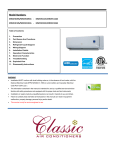

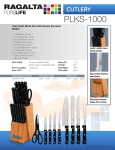
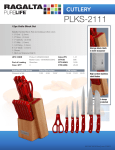
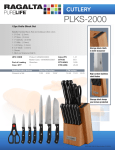

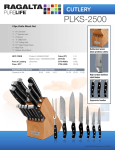

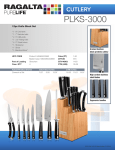
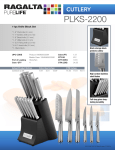
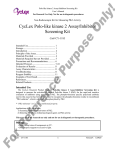
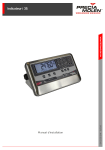
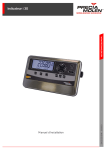




![TTF-1 [SPT24] - Zytomed Systems](http://vs1.manualzilla.com/store/data/005793963_1-173a06c06d5648223f763723a0e98383-150x150.png)
